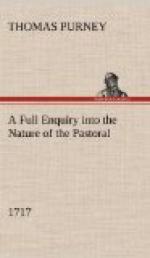If any other kinds of Images are introduced, they must be artfully qualify’d, or else be faulty; the Methods to be used in so qualifying them, are too numerous to recount. But give me leave to put down one, which relates to the Language.
Suppose you was to describe some LOVELADS and LASSES roving a little by the Sea-shore in a guilded Boat; when, on a sudden, the Wind arises, drives ’em into the middle of the Main at once, and dashes the Gondola on a Rock. Might you not describe such a boistrous Circumstance in an easy and Pastoral manner.
Sore raven the fell Sea (Oh sorry Sight!)
And strait (most wofull Word) the Boat
doth split.
But these are things which are better left to the Writer’s own Genius, than to Rule and Criticism.
As to the gloomy Images, I shall only caution the Pastoral Writer, that they must be of a very different Nature from those in Epick Poetry or Tragedy: That is, the gloomy must not be so strong; but the Images must rather contain a pleasing Amusement. And that they’ll do, if they are drawn from the Country: As Fairies; Will-o’-Wisps; the Evening; falling Stars; and the like, will all furnish Images exactly agreeable to Pastoral.
Having made this Observation on the Gloomy Images, let us now proceed to the Consideration of the Beautiful, which will detain us somewhat longer.
SECT. 2.
Of Beautiful Images. And of those; which are more, which less fine.
In my usual way of considering Beautiful Images; for the greater Clearness, I rank ’em into three several Classes. This division I do not desire to impose on any one else; but the mentioning it, cannot be amiss.
Of the three sorts or kinds of Beautiful Images, the first, and least delightful is, where only a simple Image is exhibited to the Reader’s Mind. As of a Fair Shepherdess.
The second Sort is, where there is the Addition of the Scene; as suppose we give the Picture of the fair Shepherdess, sitting on the Banks of a pleasant streamlet.
The third, and finest kind of Beautiful Images is, where the Picture contain’s a still further Addition of action. As, the Image of a fair Shepherdess, on the Banks of a pleasant Stream asleep, and her innocent Lover harmlessly smoothing her Cloaths as flutter’d by the Wind. And the most beautiful Image in Phillips, or I think any Pastoral-Writer, is of this Nature.
Once Delia lay, on easy Moss reclin’d; Her lovely Limbs half bare, and rude the Wind. I smooth’d her Coats, and stole a silent Kiss; Condemn me, Shepherds, if I did amiss.
Past. 5.
The last Line contains a Pastoral Thought, of the best Sort; as the three first a Pastoral Image.
The middle of this last Pastoral is full of beautiful Images, and has therefore proved so Entertaining to all Readers, that I wonder Mr. Phillips would not give us the Beautiful in his four first Pieces also.




